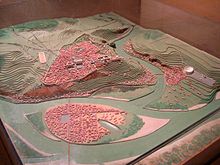Lugdunum (museum)
| Data | |
|---|---|
| place |
Lyon |
| architect | Bernard Zehrfuss |
| opening | November 1975 |
| Number of visitors (annually) | 97774 (2011) |
| Website | |
Lugdunum (originally Musée gallo-romain ) is an archaeological museum in Lyon , France , that covers the Gallic and Roman eras of the city's history. It includes the former covered museum wing and, since November 2017, the Roman theater on the Fourvière hill , so it is in the heart of the former Roman city of Lugdunum. The administration is in the hands of the city of Lyon. There are also regular temporary exhibitions in the museum.
Story and concept
The museum was built by the architect Bernard Zehrfuss and inaugurated in 1975. The building is on the edge of the ancient site that stretches up the slope. Inside, it consists of a ramp made of exposed concrete that winds down and leads to the platforms on which the exhibits are presented. These are mainly finds from Lyon and the surrounding area, plus some pieces that were discovered elsewhere. Above all, engraved stones, statues, pieces of jewelery, objects of daily life etc. are exhibited. The museum is designed in such a way that insights into the remains of the theater and the Odeon are possible.

A relief plan of the ancient Lugdunum showed the reconstructed appearance of the city, which was built on the Fourvière hill and dominated the island (now the peninsula). This illustration reflected the state of knowledge from 1975 and was based on the theories of Amable Audin . This old model was replaced in 2015 by another with a glowing animation that helps to follow the history of the town on the Fourvière hill. This model also shows the main ancient monuments in their location: Capitol Temple, Theater and Odeon.
The racetrack is remembered by a mosaic that shows the chariot races held there in detail. Discovered in 1806 in the Ainay district, this mosaic is one of the rare representations of ancient races. The fragments of the altarpiece for Roma and Augustus shown in the museum come from the Ara trium Galliarum .
Collections
The museum gives a large space to the objects of Gallo-Roman craftsmanship: ceramics, mosaics, but also metal art and glassware as well as a pottery furnace. Scales and weights demonstrate Lugdunum's reputation as a trading center between the Rhône and the Saône. Objects from the Celtic era before the Roman conquest are also shown.
The museum's outstanding exhibits include:
- Tabula Claudiana ; a bronze plaque on which a speech by the emperor Claudius is written.
- Coligny calendar ; a calendar in the Gallic language, one of the few surviving evidence of this language.
- Taurobolium altars ; one of them was dedicated to the recovery of Emperor Antoninus Pius in 160
- Numerous ancient mosaics from ancient Lyon, including depictions of Dionysus on a panther, the drunken Heracles and a struggle of love ( Eros ) against instinct ( Pan )
- Some well-preserved panels of wall cladding giving an impression of the painted decoration of ancient buildings
- Several large sarcophagi, including the “Sarcophagus of the Triumph of Bacchus” and a cast of the early Christian “Sarcophagus of Balazuc” from the 5th century (the original of which is in the town hall of Balazuc )
- Vernaison treasure : many axes, sickle leaves and other Bronze Age objects found in Vernaison
- Treasure of Lyon-Vaise : silver dishes, jewelry and statuettes buried during a Germanic invasion in the 3rd century
literature
- Stéphanie Boucher, Suzanne Tassinari: Musée de la civilization gallo-romaine à Lyon. Volume 1: Inscriptions, statuaire, vaisselle. Diffusion de Boccard, Lyon 1976.









